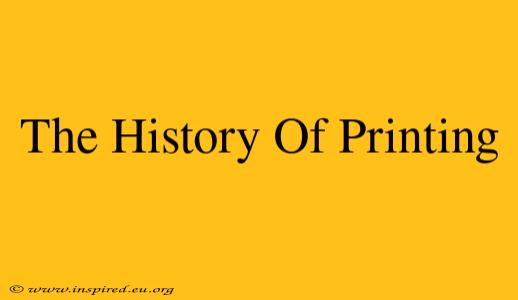The history of printing is a long and fascinating journey, reflecting humanity's constant drive to record and share knowledge. From rudimentary clay tablets to the sophisticated digital printing methods of today, the evolution of printing technology has profoundly impacted society, communication, and the spread of ideas.
Early Forms of Printing: Before the Printing Press
Before the invention of the printing press, information dissemination was a painstakingly slow process. Methods like carving symbols into clay tablets (Mesopotamia, circa 3200 BCE) and creating hieroglyphics on papyrus (Ancient Egypt) were early forms of communication, but hardly efficient for mass production.
Woodblock Printing: A Step Towards Mass Production
Woodblock printing, originating in China during the 7th century, represented a significant leap forward. Artists would carve characters and images into wooden blocks, then ink them and press them onto paper or fabric. This method allowed for multiple copies, although it remained laborious and time-consuming. Woodblock printing spread across Asia, influencing the development of printing techniques in other cultures. It became particularly important in Japan for creating beautiful woodblock prints known as Ukiyo-e.
The Rise of Movable Type: A Revolutionary Invention
The invention of movable type is arguably the most pivotal moment in printing history. While its exact origins are debated, early forms appeared in China during the 11th century. However, it was Johannes Gutenberg's innovation in the mid-15th century in Europe that truly revolutionized the process. Gutenberg's printing press, utilizing individual, reusable metal type, vastly increased printing efficiency and accuracy. His famous Gutenberg Bible, printed around 1455, marked a turning point. It made books more accessible and affordable, fueling the Renaissance and the Reformation.
The Printing Press and its Impact
Gutenberg's printing press dramatically altered the course of history. The ability to mass-produce books led to several crucial changes:
- Increased Literacy: Wider access to books fueled a surge in literacy across Europe.
- Spread of Knowledge: Scientific discoveries, religious texts, and philosophical ideas circulated much more rapidly.
- Rise of Nationalism: Printed materials helped standardize languages and foster national identities.
- The Reformation: Martin Luther's ideas spread swiftly thanks to the printing press.
The printing press was quickly adopted across Europe and beyond. Printing houses sprang up in major cities, transforming the way information was created, disseminated, and consumed.
Printing's Evolution: From Gutenberg to the Digital Age
Following Gutenberg's invention, several innovations continued to improve printing technology:
- The development of different printing presses: These included the cylinder press, offering faster printing speeds, and the rotary press, capable of printing on continuous rolls of paper.
- Improvements in ink and paper: These advancements enhanced the quality and durability of printed materials.
- The introduction of lithography: This method used flat stones or metal plates to print images, allowing for greater detail and more complex designs.
- The invention of photography and photoengraving: This allowed for the easy reproduction of images within printed materials.
The 20th and 21st centuries witnessed further dramatic changes. The invention of offset lithography revolutionized printing, and digital printing methods now dominate. These advancements have made printing faster, more efficient, and more affordable than ever before. They've also diversified print applications beyond books and newspapers, into things like packaging, advertising, and personalized products.
The Future of Printing
Digital printing continues to evolve rapidly. New technologies like 3D printing are pushing the boundaries of what's possible. While electronic media has undoubtedly impacted print's role in modern society, print remains a vital form of communication. Its tactile nature and unique aesthetic qualities ensure its continued relevance.
The history of printing is a story of innovation, cultural exchange, and transformative societal impact. From the earliest attempts at recording information to the sophisticated technologies of today, the journey reflects our enduring need to communicate, learn, and share our stories. The future of printing remains bright, promising further innovations and creative applications in the years to come.
